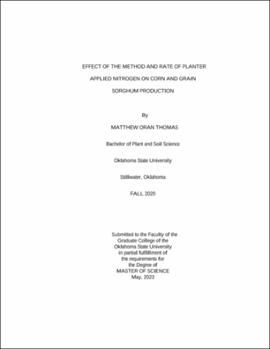| dc.contributor.advisor | Arnall, Brian | |
| dc.contributor.author | Thomas, Matthew Oran | |
| dc.date.accessioned | 2023-08-25T20:06:36Z | |
| dc.date.available | 2023-08-25T20:06:36Z | |
| dc.date.issued | 2023-05 | |
| dc.identifier.uri | https://hdl.handle.net/11244/338969 | |
| dc.description.abstract | In Oklahoma corn (Zea mays) and grain sorghum (Sorghum bicolor L) account for nearly 20% of all the total value of farmed cropland in the state. Fertilizer, specifically nitrogen (N) is one of the greatest input cost and potential environmental risk points for the central Great Plains producers. It is well documented that preplant N is inefficient and both crops benefit from in-season N management. However, it is also documented in some studies that there is a positive response to planter applied N. The placement and timing of in-season applied N is well researched but there is a lack of data on planter applied N fertilizer in the region and none that evaluates the method and rate of such an application. The objective of this study was to test the impact of the method and rate of planter applied N on plant stand and grain yield of corn and grain sorghum in central Oklahoma. The placement methods evaluated were in-furrow, surface dribble, dry surface broadcast, and “2x2” coulter injected. Nitrogen rates evaluated in this study were 9, 18, and 27 kg N ha⁻¹, as well as a non-fertilized check for a total of 13 treatments. Fertilizers utilized in the study included liquid urea-ammonium nitrate (28-0-0) and Urea (46-0-0). The study was repeated over three growing seasons: 2020, 2021, and 2022 with 2 locations per year in central Oklahoma, USA. Stand counts for the corn averaged 20.3 plants per row (each row was 6 m-1 in length for both crops) across all sites and treatments. The grain sorghum stands average 36 plants row⁻¹. Overall site years corn grain yields averaged 3.1 Mg ha⁻¹ while the grain sorghum trials averaged 1.8 Mg ha⁻¹ across the six locations. These yield values were well below expected for a managed research study as the state average for the same period was 8.6 Mg ha⁻¹ and 2.37 Mg ha⁻¹ for corn and grain sorghum respectively. The results of this study were that neither stand nor grain yield were statistically impacted by neither the N placement method nor N rate in both corn and grain sorghum. While low yields were expected due to reduced N application rates this research experienced exceptionally low yields and no response to N rate suggesting N was not the limiting factor. Across all site years and crops the environment and weather conditions impacted this study reinforcing the concept of Liebig’s Law of the Minimum. In which yield is control by the greatest limiting factor and in the case of the work, the greatest limiting factor was environment. | |
| dc.format | application/pdf | |
| dc.language | en_US | |
| dc.rights | Copyright is held by the author who has granted the Oklahoma State University Library the non-exclusive right to share this material in its institutional repository. Contact Digital Library Services at lib-dls@okstate.edu or 405-744-9161 for the permission policy on the use, reproduction or distribution of this material. | |
| dc.title | Effect of the method and rate of planter applied nitrogen on corn and grain sorghum production | |
| dc.contributor.committeeMember | Lofton, Josh | |
| dc.contributor.committeeMember | Warren, Jason | |
| osu.filename | Thomas_okstate_0664M_18063.pdf | |
| osu.accesstype | Open Access | |
| dc.type.genre | Thesis | |
| dc.type.material | Text | |
| dc.subject.keywords | corn | |
| dc.subject.keywords | nitrogen | |
| dc.subject.keywords | salt | |
| dc.subject.keywords | sorghum | |
| dc.subject.keywords | starter | |
| thesis.degree.discipline | Plant and Soil Sciences | |
| thesis.degree.grantor | Oklahoma State University | |
